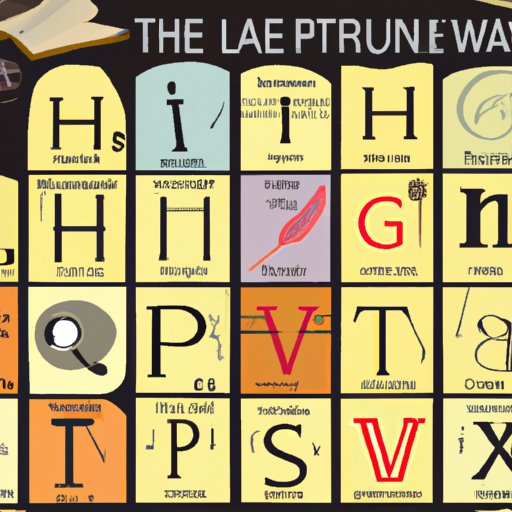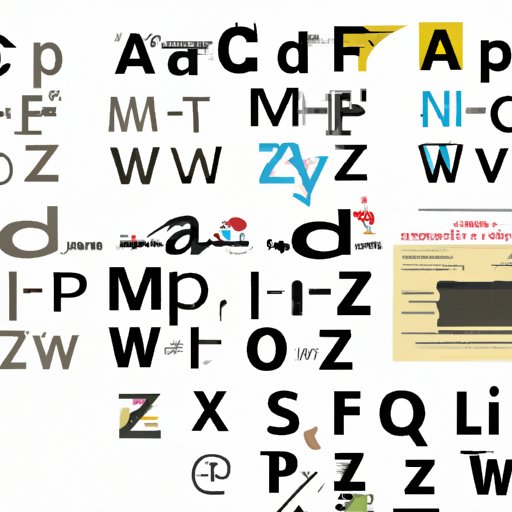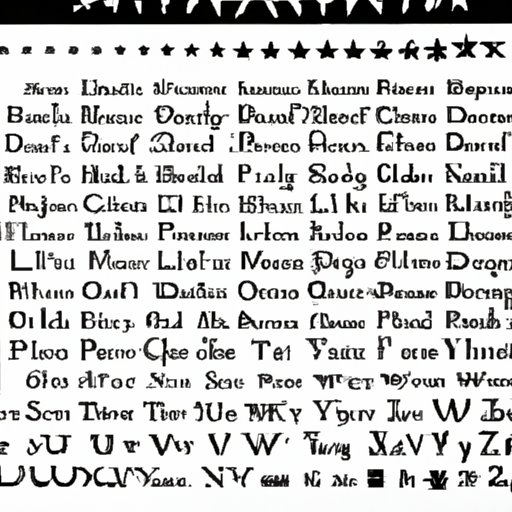Introduction
The alphabet is an integral part of our lives today. We use it every day in many different ways, whether we are reading or writing, communicating or learning. But where did the alphabet come from? Who invented it and why? This article will explore the history of the alphabet from its earliest origins to the present day, uncovering the mystery of who invented alphabets from A to Z.
An alphabet is a set of symbols that represent sounds. It is usually arranged in a fixed order such as A-B-C-D-E-F-G and so on. The word “alphabet” comes from the first two letters of the Greek alphabet: alpha and beta. The English alphabet is made up of 26 letters and is used to write the English language.
The purpose of this article is to examine the origin and evolution of alphabets from A to Z. It will trace the history of the alphabet from its earliest forms to the present day, exploring the role of technology in its evolution, and examining the impact of other cultures on alphabet design.
Historical Overview of the Evolution of Alphabets from A to Z
The origin of the alphabet can be traced back to ancient times. Writing systems have been around for thousands of years, and alphabets have evolved over time. The earliest known writing system was developed by the Sumerians in Mesopotamia around 3500 BCE. This writing system was called cuneiform, and it consisted of wedge-shaped marks carved into clay tablets.
Around 2000 BCE, the Egyptians developed their own writing system called hieroglyphics. This writing system used symbols representing objects, animals, and ideas in place of letters. Around 1500 BCE, the Phoenicians developed a new writing system called the Phoenician alphabet. This was the first alphabet consisting of consonants only.
The Phoenician alphabet spread throughout the Mediterranean world and was adapted by the Greeks and Romans. The Greeks developed their own version of the alphabet, adding vowels to the consonants. This alphabet became known as the Greek alphabet and is still used today. The Romans also adapted the Greek alphabet, creating the Latin alphabet which is still used in many languages today.
The alphabet spread around the world, with each culture adapting the letters to fit their own needs. As the alphabet spread, it changed and evolved, giving rise to the alphabets we know today.

Who Invented the Alphabet: Exploring the Origin of Letters
The origin of the alphabet is a complicated and contested subject. Many theories exist about who invented the alphabet, and no one theory has been universally accepted. However, there are three main theories about the origin of the alphabet.
The first theory is that the Phoenicians invented the alphabet. The Phoenicians were a seafaring people living on the coast of modern-day Lebanon. They developed a writing system called the Phoenician alphabet around 1500 BCE. This alphabet consisted of 22 letters and was composed only of consonants. It is believed that this alphabet was the basis for many of the alphabets used today.
The second theory is that the Greeks invented the alphabet. The Greeks adopted the Phoenician alphabet around 800 BCE and added vowels to it, creating a new alphabet known as the Greek alphabet. This alphabet was much more efficient than the Phoenician alphabet and allowed for easier reading and writing. The Greek alphabet is still used today in many languages, including English.
The third theory is that the Romans invented the alphabet. The Romans adopted the Greek alphabet and modified it to create the Latin alphabet. This alphabet was more efficient than the Greek alphabet and was adopted by many languages, including English.
Tracing the History of the Alphabet from Its Earliest Forms to the Present Day
The alphabet has undergone many changes since its earliest forms. Over time, new letters have been added and existing letters have been changed or removed. Technology has played an important role in the evolution of the alphabet. The invention of the printing press in the 15th century made it easier to produce books and newspapers, and this led to an increase in literacy rates. This in turn led to increased demand for books and newspapers, which had an impact on the development of the alphabet.
The Industrial Revolution of the 18th and 19th centuries saw further advances in technology, including the invention of typewriters and computers. These inventions made it easier to write, print, and distribute documents, and this had a significant impact on the evolution of the alphabet.
The Creation of Language: Examining the Development of Alphabets from Ancient Times
The development of writing systems has had a profound impact on language development. Before the invention of writing, words were passed down orally and could change over time. With the invention of writing, words could be written down and preserved. This allowed for the development of complex language structures and the spread of ideas.
The influence of other cultures on alphabet design cannot be underestimated. The spread of the alphabet around the world led to the adoption of letters from other languages. For example, the Latin alphabet adopted the letter “J” from the Germanic languages, and the letter “K” from the Greek alphabet.

Mapping the Alphabet: A Timeline of A to Z
The following timeline outlines the major changes that have occurred in the alphabet from its earliest forms to the present day.
- 3500 BCE – Sumerians invent cuneiform writing system.
- 2000 BCE – Egyptians invent hieroglyphics.
- 1500 BCE – Phoenicians invent the Phoenician alphabet.
- 800 BCE – Greeks adopt the Phoenician alphabet and add vowels, creating the Greek alphabet.
- 100 BCE – Romans adopt the Greek alphabet and modify it, creating the Latin alphabet.
- 1450 CE – Johann Gutenberg invents the printing press.
- 18th and 19th centuries – Industrial Revolution leads to the invention of typewriters and computers.

The Mystery of Letter Writing: Uncovering the Origins of Alphabets from A to Z
The origin of the alphabet is a mystery that has puzzled scholars for centuries. While there are many theories about who invented the alphabet and why, there is no definitive answer. What is certain, however, is that the alphabet has had a profound impact on language development and the spread of ideas.
The historical significance of alphabet letters cannot be underestimated. Through the decipherment of ancient texts, scholars have uncovered many secrets about the past. By studying these texts, we can gain valuable insights into the lives of our ancestors and the development of human civilization.
Conclusion
In conclusion, the alphabet is an integral part of our lives today. It has a long and fascinating history, and its evolution from A to Z has been shaped by many different factors. The origin of the alphabet is still a mystery, but it is clear that it has had a huge impact on language development and the spread of ideas.
This article has explored the history of the alphabet from its earliest forms to the present day. It has examined the role of technology in its evolution, and explored the impact of other cultures on alphabet design. Finally, it has traced the mystery of letter writing and uncovered the origins of alphabets from A to Z.
(Note: Is this article not meeting your expectations? Do you have knowledge or insights to share? Unlock new opportunities and expand your reach by joining our authors team. Click Registration to join us and share your expertise with our readers.)
